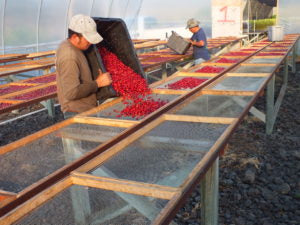Drip or Immersion?
All coffee brewing can be put into one of two categories, drip brewing or immersion brewing. Drip brewing includes automatic brewers, pod and capsule brewers, Aeropress, espresso, moka pot, percolator and manual pour overs. Immersion brewers include campfire coffee, Turkish coffee, siphon coffee, clever style brewers and French press coffee. Given exactly the same beans roasted to the same degree the choice of brewing method will change the flavor of the coffee.
Matching your taste to the brew method and the coffee bean variety is an art.
Drip Brewers
Not all drip brewers are equal. Given the same coffee, ground the same way, there is a noticeable difference in coffees from different drip brew methods.
Some drip brewers only allow contact with the brewing water for short periods. It takes time to extract the flavor oils from coffee grounds. Automatic drip brewers with short extraction times such as Mr. Coffee style brewers, pod and capsule and espresso brewers leave behind the more subtle flavors of gourmet coffee. Newer automatic Mr Coffee style brewers are remedying this problem by pulsing the water into the brew basket with a longer brew period.
In general, manual drip brewing tends to bring out more flavors than immersion brewing.. Assuming that the drip brewer has enough time to extract the oils in the coffee grounds, the result is more complex coffee with more subtle flavors.
Every drip brewer has its pros and cons.
Drip Brewing Pros
V60 The manual pour over V60 brewer emphasizes the beans’ acidity and floral notes with moderate body. Hario has an automatic V60 brewer which pulses the water into the brew basket creating a close to V60 manual pour over flavor in the coffee.
Chemex The manual pour over Chemex with its chem lab paper filter retains both the solids and the coffee oils. The result is an exceptionally clean tasting coffee with moderate flavor.
Kalita Wave The manual pour over Kalita Wave has a flat-bottomed base and three exit holes which tend to retain the brew water for a longer time than a V60. This gives the water time to extract more of the natural sugars and flavor oils in the bean.
Aero Press The manufacturers’ recommended brewing method uses a 30 second steep time. AeroPress pros extend this time to 1 to 2 mintues by turning the brewer upside down. In either case the brewer creates a concentrated brew with no solids. The AeroPress brewer emphasises the acidity and the aroma of the coffee.
Mr. Coffee style brewers, pod and capsule, pulsing automatic brewers The best thing about automatic brewers is that they are convenient. Push the button, go do something else and the coffee will be waiting. The worst thing is poor extraction. You can’t expect to pull amazing flavors from a coffee bean with only a few seconds of contact with the brew water. Some of the newer automatic brewers are helping by pulsing the brew water into the brew basket creating about a three minute extraction.
Drip Brewing Cons
Consistency Getting the same brew each time is more difficult in drip brewing, especially manual drip brewing.
Channeling When the water creates channels through the coffee grounds it results in some grounds getting more extraction than others.
Temperature Maintenance Keeping the brew water at the same temperature each time is difficult in manual drip brewing.
Immersion Brewing
Immersion brewing is the oldest method of brewing coffee. Two examples are Turkish coffee and campfire coffee where the grounds are put into the water and then boiled. In both cases the coffee is over extracted, acidic and bitter.
Immersion Brewing Pros
French Press Coffee gourmets who like more mouthfeel in their coffee like French Press brewed coffees. The metal filters in French Presses allow more solids to pass through to the cup. Because French Presses provide total immersion of the grounds all of the oils and flavors in the coffee are extracted. Paper filters in other brew methods soak up the oils in coffee and inhibit the passage of solids.
Clever Style Brewers The Clever style brewers attempt to cross over French Press brewing with pour over brewing. There are a number of different brewers but the basic process is that the grounds and water are steeped together in a brew basket and then allowed to pour out the bottom of the basket through a filter. Some of the brewers require the addition of a paper filter, others have a built-in filter. One advantage is that the grounds are not pressed which tends to keep harsh acids out of the brew. Clever brewers have less solids (mouthfeel) than French Presses. If they require a paper filter they also have less flavor oils.
Siphon or vacuum pots In a siphon brewer water is heated in a chamber sealed to another chamber that contains coffee grounds. As the water heats it is forced into the chamber with the grounds. When extraction is finished the heat is turned off and the coffee returns to the first chamber through a filter. Siphons brewers use plastic, metal or cloth filters. The result is a clean brew with little solids. Siphon brewed coffee has excellent aroma and full flavor.
Immersion Brewing Cons
Immersion brewers are messy and more difficult to clean than drip brewers. They also require more attention and are less convenient than automatic brewers. Immersion brewers have a reputation as weekend brewers when consumers have more time.

